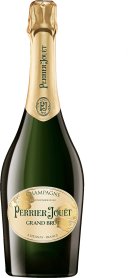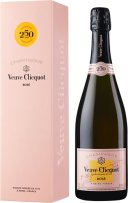Larmandier Bernier Latitude Non-Vintage
Latitude is a 100% Côte de Blancs Chardonnay, predominantly grown, as it always has been, in vineyards on the southern side of Vertus. These are vineyards on roughly the same
Perrier-jouet Grand Brut Non-Vintage
"Fresh, clean, vibrant iced pastry aroma, lovely and chard-ish. Similarly clean and fresh in the mouth, with evident dosage, but also a clean finish, soft and equable. A very easy drinking wine and well turned-out." 92 points Huon Hooke
Moet & Chandon Vintage Champagne
The Grand Dame of Moet & Chandon the Vintage has spent years in the cellars to emerge as a star of the Champagne line. It's best to just pop the cork and fall in love all over again this Valentines Day.
Veuve Clicquot Non-Vintage Rose
Elegant and fruity, this wine frees the senses, charms the eye and ravishes the palate. Proudly bearing the imperial red signature of Madame Clicquot. It is a delicious rosé Champagne with plenty of character. 'THIS is one of the go-to French brands for a Valentine's moment. It's all about the name, the sunset brushstroke of this rose´ and its abundant presence in the glass. There is a cherry to redcurrant-fruit focus and even a background note of sarsaparilla.' - Herald Sun, Melbourne, 12 Feb 2013
Veuve Clicquot Ponsardin Vintage
Veuve Clicquot has been producing fine quality Champagne since it was founded in 1772. In 1810, Madame Clicquot broke new ground by creating the first vintage Champagne, made of grapes from one single harvest. Veuve's non vintage is consistently rated in the top handful of NV Champagnes and delivers a powerful bubbly with a rich mouthfeel. The Ponsardin vintage is elegant with generous freshness and the Pinot Noir lends body to a very lively wine. On the palate there's layers of floral and fruity complexity that flows into a remarkably long and powerful finish.
Billecart Salmon Brut Rose Non-Vintage Champagne
Founded in 1818 by Nicolas Francois Billecart and his spouse Elizabeth Salmon in Mareuil-sur-Ay, this is one of the few houses that have remained in the same family. Seven generations on, the house is led by the very talented Francois Roland-Billecart. They espouse three principal aims are finesse, balance and elegance and the Brut rose is testament to this. Pale salmon pink in colour, the nose shows lifted red fruits and fresh pear. The Pinot has given structure to the blend while the Chardonnay has given a wonderful elegance and delicacy. A blend of 40% chardonnay, 20% Pinot Meunier, and 40% Pinot Noir. Of the Pinot component 8% is still wine from the family vineyards in Mareuil.
Agrapart & Fils 7 Crus Extra-Brut Non-Vintage
Product Information: The NV Brut 7 Crus is a very pretty. Bright, mineral and intensely vibrant, the 7 Crus is full of energy and refreshment. 7 Crus is a blend of two harvests: in this case, 60% is 2021 from 1er Cru sites; and 40% is 2020 from Grand Cru sites. The reserve wine was raised in neutral, 600-litre oak casks from François Chidaine and Didier Dagueneau. The breakdown is 90% Chardonnay and 10% Pinot Noir. Even at this first level, the wine is aged for three years on lees. It was disgorged with 6 g/L dosage. This is the most immediately seductive cuvée in the Agrapart range, yet it is still extremely fine. It’s long, deep and saline with some gentle grip. Sadly, we do not get nearly enough. The reviews below refer to a previous disgorgement. Disg. March 2024. The Agrapart range begins with a non-vintage wine called 7 Crus. The name refers to the seven Côte des Blancs villages from which the wine derives. These include Avize (from younger vines aged 20 to 40 years), Cramant, Oger, Oiry, Avenay-Val-d’Or, Coligny and Vauciennes. Like all Agrapart wines, the fruit is from 100% estate-owned and farmed vineyards. Maker: In 1894 at the beginning of France’s lively Belle Époque “the beautiful era” or Europe's golden era between 1871 to 1914. Arthur Agrapart started the family domaine that would become Champagne Agrapart & Fils. The estate has weathered many storms, including World War I, an economic depression, and the German Occupation during World War II, which devastated stock by millions of cases throughout the region. In the 1950s, Arthur’s grandson Pierre set out to rebuild the family business by making wines of quality rather than following the commercial trends of the day. Pierre’s sons Pascal and Fabrice took over the reins in 1990, farming their own vineyards along the prestigious Côte de Blancs, as well as blending and bottling their own wines. By the early 2000s, upon realising the brothers did not have the same goals for the future of the estate, Pascal began the long-term process of dividing the estate in two. His vineyards would become the backbone of Domaine Pascal Agrapart, focusing on the unique single vineyard cuvées that he had championed since the early 1990s and the remaining family vineyards would provide the fruit for the assemblage cuvées, 7 Crus & Terroirs, still bottled under the Agrapart & Fils label today. Pascal has been joined by his eldest son Ambroise and their ultimate goal is to produce only wines bearing the Pascal Agrapart label. Philosophy: The winery is based in the grand cru village of Avize, famous for its cuvees of 100% Chardonnay. Pascal and Ambroise farm 10 hectares from some 60 different vineyard plots in the Côte de Blancs, including Oger, Cramant, Oiry and Avize. They farm using only homeopathic vine treatments, composts, manures, and regular plowing. The Agraparts were one of the first families to bring the draft horse back to the vineyards, and named a cuvee in honour of their first four-hooved friend, Vénus. In plowing the old-school way, they expose the clay and limestone soils to immune-boosting properties of the wind and sun. While they once were the object of ridicule, they now lead a return to authentic, ancestral practices. Their quality control extends to manual harvests, a selective triage of the grapes, and the use of native yeasts during fermentation. Malolactic fermentations are employed to round out the intensity of these mineral-driven Champagnes. The wines age on their lees for an extended period of time, and then are racked to both stainless steel and neutral oak barrels—the latter being a rarity in Champagne before Pascal started using them. All wines are bottled unfined and unfiltered. Nose - Apricots, Pears, Fennel Vibrant fruit here, with peaches, apricots, lemons, pears, almonds and spicy anise notes. Palate - Intense Minerality, Pillowy Palate, Citrus Peel medium to full-bodied, ample and pillowy palate. Finish - Chalk, Lingering Citrus, Saline White flowers, chalk and citrus linger.
Charles Heidsieck Vintage
On the nose, it is autumnal and warm, with surprising aromas of praline and lightly toasted hazelnuts. On the palate, its incredible balance offers a firmness to be expected from great Champagne. The Charles Heidsieck Vintage 2005 is a wine of distinct character, from an exceptional vintage.
Moet & Chandon Imperial Brut Non-Vintage
Moët & Chandon Impérial Brut Champagne Brut Impérial is Moët & Chandon signature house cuvée and the worlds best-selling Champagne. Established by Claude Moët, the house can trace its history back to 1743. Blended from over 200 crus, bringing together the structure of Pinot Noir, class of Chardonnay and the suppleness of Pinot Meunier.
Moët & Chandon Grand Vintage Champagne
Moët & Chandon is arguably the most famous name in the world of Champagne and "Moet" lives up to the hype. Its successful reputation is primarily built on the quality and finesse of its wines, as well as its widespread publicity. The vintage cuvée (based on Pinot Noir fruit) is rich and complex with lovely notes of brioche and almond. Moët Vintage is perfect as an aperitif or surprsingly with many wide and varied food matches.


















